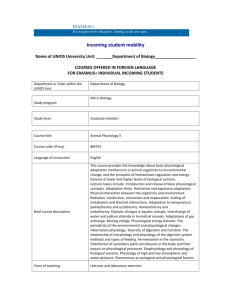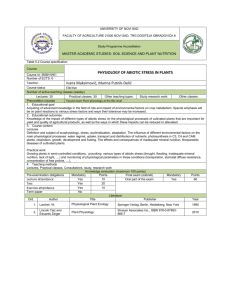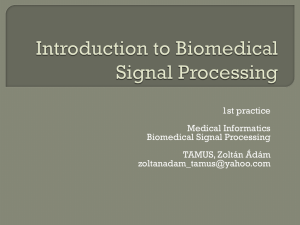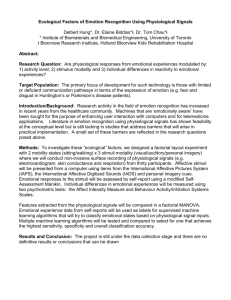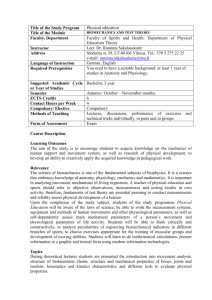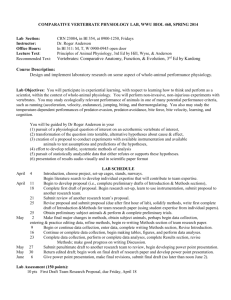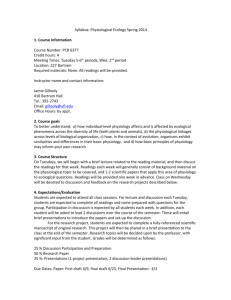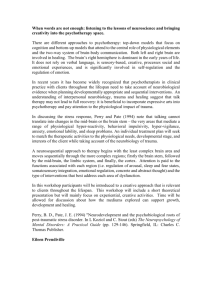Biology 477 Laboratory Course (1 units)
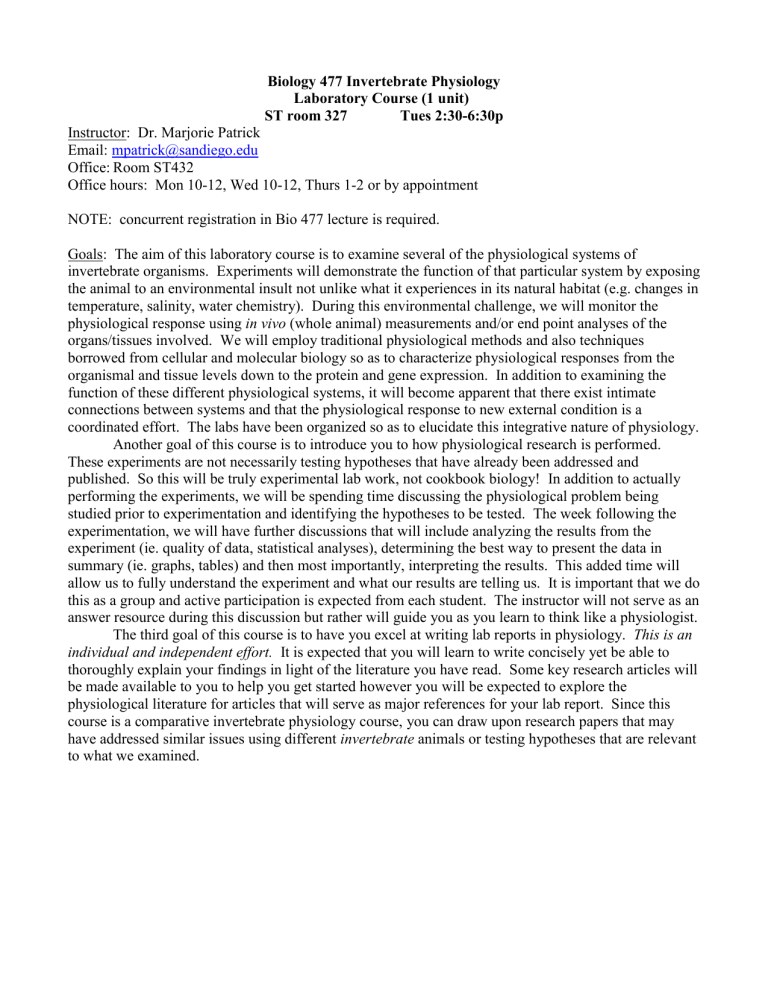
Instructor: Dr. Marjorie Patrick
Biology 477 Invertebrate Physiology
Laboratory Course (1 unit)
ST room 327 Tues 2:30-6:30p
Email: mpatrick@sandiego.edu
Office: Room ST432
Office hours: Mon 10-12, Wed 10-12, Thurs 1-2 or by appointment
NOTE: concurrent registration in Bio 477 lecture is required.
Goals: The aim of this laboratory course is to examine several of the physiological systems of invertebrate organisms. Experiments will demonstrate the function of that particular system by exposing the animal to an environmental insult not unlike what it experiences in its natural habitat (e.g. changes in temperature, salinity, water chemistry). During this environmental challenge, we will monitor the physiological response using in vivo (whole animal) measurements and/or end point analyses of the organs/tissues involved. We will employ traditional physiological methods and also techniques borrowed from cellular and molecular biology so as to characterize physiological responses from the organismal and tissue levels down to the protein and gene expression. In addition to examining the function of these different physiological systems, it will become apparent that there exist intimate connections between systems and that the physiological response to new external condition is a coordinated effort. The labs have been organized so as to elucidate this integrative nature of physiology.
Another goal of this course is to introduce you to how physiological research is performed.
These experiments are not necessarily testing hypotheses that have already been addressed and published. So this will be truly experimental lab work, not cookbook biology! In addition to actually performing the experiments, we will be spending time discussing the physiological problem being studied prior to experimentation and identifying the hypotheses to be tested. The week following the experimentation, we will have further discussions that will include analyzing the results from the experiment (ie. quality of data, statistical analyses), determining the best way to present the data in summary (ie. graphs, tables) and then most importantly, interpreting the results. This added time will allow us to fully understand the experiment and what our results are telling us. It is important that we do this as a group and active participation is expected from each student. The instructor will not serve as an answer resource during this discussion but rather will guide you as you learn to think like a physiologist.
The third goal of this course is to have you excel at writing lab reports in physiology. This is an individual and independent effort. It is expected that you will learn to write concisely yet be able to thoroughly explain your findings in light of the literature you have read. Some key research articles will be made available to you to help you get started however you will be expected to explore the physiological literature for articles that will serve as major references for your lab report. Since this course is a comparative invertebrate physiology course, you can draw upon research papers that may have addressed similar issues using different invertebrate animals or testing hypotheses that are relevant to what we examined.
Laboratory Reports:
The lab reports will follow the standard format of Cover Page, Introduction, Materials &
Methods, Results, Discussion and References for a physiology publication. You can refer to Journal of
Experimental Biology and Physiological Biochemistry and Zoology for format. Please examine one of these journals prior to writing your first lab report. It is important for you to understand the style, content and organization of each of the sections, especially how previously published work is cited in the text and how graphs and tables are formatted and integrated into the text. It is expected that your lab report will be typed and any results requiring graphing will be done so in Microsoft Excel or some other graphing software.
Your report will include the following :
Cover page : With lab title, date, your name
Introduction: Introduce the physiological topic to be examined and provide essential background.
Present your hypothesis to be tested with justification and explain how your will test it.
Materials and Methods . Present an overview of what experiments were performed – do not restate the step-by-step methods that the instructor gave you. Describe what important data will be collected (ie what information will be used in the final analysis).
Results : Presentation of the data. Describe your results emphasizing important findings. Your graphs and tables should only serve to summarize your data. Do not present raw data in the lab report .
Do not present your data in a table then in a figure. Just select the most appropriate format.
Tables and Graphs must be labeled properly! Consult a physiological journal (PBZ, JEB) to see the correct format for figures and tables (see below).
Discussion : Comment on whether the results support the hypothesis. If not, why not. Explain any other unanticipated findings. Explain the relevance of your findings to in light of other published results directly related to your physiological question.
References : List of scientific papers referred to in the text. Note specific format for citation in JEB or
PBZ.
Tables : With proper headings to fully explain table. A person reading your report should be able to look at the table heading and know exactly what the table is.
Figure legends : Describing each figure to follow.
Figures : Labeled clearly with proper legend, axes labels (including units!).
Your report should be double spaced, using a font of 12 pt (not less). In the report, your interpretation of your results should be logical and supported by evidence from the literature cited ( you
MUST credit any work that is not your own!!
). You need to make your arguments succinctly and focus on explaining your results. Do not spend time explaining why your results are not perfect.
Resources: Material for this laboratory course will primarily rely upon recent articles from the primary (i.e. research journals) and secondary (review articles) literature These will be made available to you to photocopy or you can access them at the library or on-line. Various comparative and insect physiology textbooks, including the course textbook for Bio 477 (Comparative Animal Physiology,
1992, P.C. Withers), will provide information on the fundamentals of each system.
Grades: Your grade will be based upon the laboratory reports you prepare and also your participation in the experiment and discussions thereof.
Introductory Lab
Weekly assignments
Experiments 1-4 reports
10 pts
100
Laboratory participation
TOTAL
100 pts each (total 400 pts)
20 pts
530 pts
Laboratory Schedule: There will be one, 4-hour laboratory each week.
Date
Sept 12
Sept 19
Sept 26
Oct 3
Oct 10
Oct 17
Week
1
2
3
4
5
5
TOPIC
Introduction, overview and prep of next week’s lab including basic laboratory skills (pipetting) and MS Excel data handling, graphing and statistical analyses
Experiment 1 : Metabolism I: Aerobic/anaerobic metabolism at the
tissue level cont’d
– sample analysis, discussion of results
cont’d – sample analysis, discussion of results
Oct 24
Oct 31
Nov 7
Nov 14
Nov 21
Nov 28
Dec 5
12
6
7
8
9
10
11
12
13
NO LAB
Experiment 2 : Metabolism II: Whole animal metabolism and the
influence of temperature cont’d
The influence of temperature at the enzyme level
cont’d analysis and discussion of Experiment II results
Experiment 3 . Osmoregulation during salinity challenge cont’d
sample analysis discussion of results cont’d
sample analysis discussion of results cont’d sample analysis discussion of results
Experiment 4 . Acid-base regulation and nitrogenous waste excretion
in aquatic inverts cont’d
–discussion of results.

